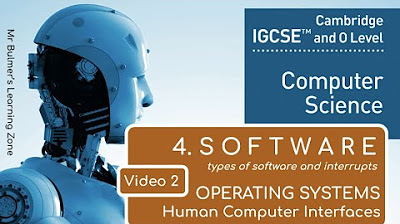Manajemen Memori 2
Summary
TLDRThis video delves into the crucial role of memory management in operating systems. It starts with monoprogramming, where only one process runs at a time, and progresses to multiprogramming, allowing for multitasking. The script covers various memory allocation methods, including static and dynamic partitioning, as well as bodying. It also explores non-contiguous allocation techniques like paging and segmentation, offering flexibility and efficiency in memory use. The video concludes with memory hole allocation strategies, highlighting their impact on system performance and the importance of understanding these techniques for effective memory management.
Takeaways
- 😀 Monoprogramming allows only one process to run at a time, dedicating all memory to that process.
- 😀 In multiprogramming, multiple processes can run concurrently, increasing system efficiency and flexibility.
- 😀 Static partitioning divides memory into fixed-size blocks, which may lead to internal fragmentation if processes are smaller than the allocated blocks.
- 😀 Dynamic partitioning allocates memory based on process size, reducing internal fragmentation but causing external fragmentation.
- 😀 The buddy system is a dynamic partitioning method that divides memory into powers of 2, ensuring more efficient allocation.
- 😀 Paging breaks processes into small blocks called pages and allocates them to frames in memory, eliminating external fragmentation but possibly causing internal fragmentation.
- 😀 Segmentation divides memory based on functional units like code, data, and stack, allowing dynamic memory allocation and reducing fragmentation.
- 😀 Memory management algorithms such as first fit, best fit, next fit, and worst fit determine how memory is allocated and affect system performance.
- 😀 The first fit algorithm selects the first available memory hole that is large enough for the process, while best fit chooses the smallest fitting hole.
- 😀 Fragmentation, both internal and external, can be a significant challenge in memory management, requiring strategies like memory compaction to resolve.
- 😀 Effective memory management ensures stability and performance of the system by preventing issues like ‘not responding’ errors when too many processes consume resources.
Q & A
What happens when a computer or device stops responding during heavy usage?
-This issue occurs due to overwhelming memory management tasks. When multiple applications or processes are running, the system may struggle to manage memory effectively, causing the device to stop responding.
What role does memory management play in an operating system?
-Memory management is a core function of an operating system that ensures the efficient and stable allocation of memory to processes. Without proper memory management, the system would face performance issues and instability.
What is monoprogramming, and how does it manage memory?
-Monoprogramming refers to a system where only one program or process runs at a time. All system resources, including memory, are allocated to this active process. Memory is protected through registers, relocation, and limit registers to prevent illegal access.
How does multiprogramming differ from monoprogramming?
-Multiprogramming allows multiple processes to run concurrently, unlike monoprogramming, where only one process runs at a time. Multiprogramming is preemptive, meaning processes can be interrupted and switched in and out of memory to optimize resource use.
What are the main methods of memory allocation in multiprogramming?
-Memory allocation in multiprogramming includes contiguous allocation methods (static partitioning, dynamic partitioning, and buddy system) and non-contiguous methods (paging and segmentation). These methods help manage memory in different ways to maximize efficiency.
What are the advantages and disadvantages of static partitioning?
-Static partitioning divides memory into fixed-size blocks. While simple, it can cause internal fragmentation if the allocated block is larger than the process, leaving unused space in the partition.
What is dynamic partitioning, and how does it handle memory allocation?
-Dynamic partitioning allocates memory according to the actual size of processes, eliminating internal fragmentation. However, it can result in external fragmentation, leaving small, unusable gaps of free memory.
What is the buddy system, and how does it differ from other memory allocation methods?
-The buddy system is a dynamic memory allocation method that uses power-of-two sizes (e.g., 2 KB, 4 KB, 8 KB). If a process's memory request doesn’t match a block size, the block is split into smaller ones. This method reduces fragmentation compared to other methods.
What is the difference between paging and segmentation?
-Paging divides the process's address space into fixed-size pages, while the physical memory is divided into frames. Segmentation, on the other hand, divides the process's memory based on logical divisions, like code, data, and stack. Paging eliminates external fragmentation, while segmentation provides more logical memory management but can result in external fragmentation.
What are the memory allocation algorithms, and how do they impact system performance?
-Memory allocation algorithms include first fit, best fit, next fit, and worst fit. Each has its strengths and weaknesses in terms of speed and memory usage efficiency. The choice of algorithm can significantly impact the system’s performance, with different algorithms affecting the speed of memory allocation and the likelihood of fragmentation.
Outlines

Esta sección está disponible solo para usuarios con suscripción. Por favor, mejora tu plan para acceder a esta parte.
Mejorar ahoraMindmap

Esta sección está disponible solo para usuarios con suscripción. Por favor, mejora tu plan para acceder a esta parte.
Mejorar ahoraKeywords

Esta sección está disponible solo para usuarios con suscripción. Por favor, mejora tu plan para acceder a esta parte.
Mejorar ahoraHighlights

Esta sección está disponible solo para usuarios con suscripción. Por favor, mejora tu plan para acceder a esta parte.
Mejorar ahoraTranscripts

Esta sección está disponible solo para usuarios con suscripción. Por favor, mejora tu plan para acceder a esta parte.
Mejorar ahoraVer Más Videos Relacionados

20 Basic Operating System Interview Questions & Answers - Freshers & Experienced - Tech Interviews

39. OCR GCSE (J277) 1.5 Operating systems 1

IGCSE Computer Science 2023-25 - SOFTWARE: Video 2 - THE OPERATING SYSTEM

Bab 8 Operating System (1) up

Operating System Interview Questions and Answers - Part I

Lecture 01 : Introduction
5.0 / 5 (0 votes)
